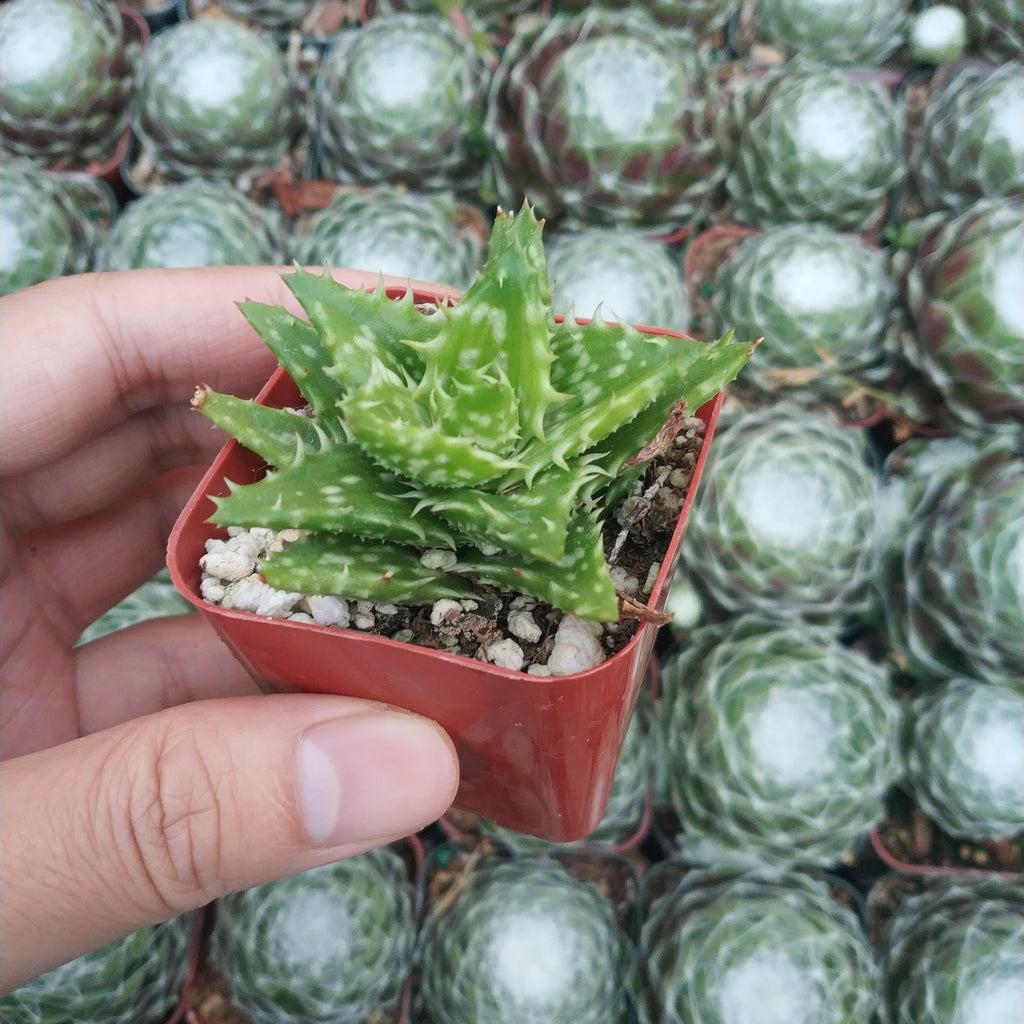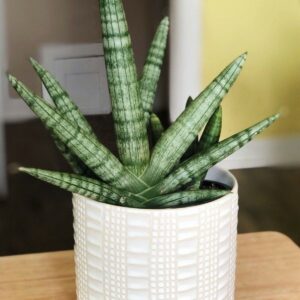🌿✨ Tiger Tooth Aloe is the common name for Aloe juvenna.
Tiger Tooth Aloe, sometimes known as Aloe juvenna, is a lovely, small, and prickly succulent that comes from Kenya. It is a farmed species, possibly of hybrid origin, though it seems to be wild. The moniker “Tiger Tooth Aloe” comes from its prized triangular leaves that are bright green, have creamy white spots, and have serrated, toothy edges.
Because this aloe species is hardy, simple to maintain, and perfect for novices, it is. Rock gardens, indoor pots, and container gardens are some of the locations where it is frequently employed to impart texture and vibrancy.
🌿 A Botanical Summary
Scientific Name: Aloe juvenna
Common Names: Tiger Tooth Aloe
Family: Asphodelaceae
Origin: Kenya (cultivated, but there is no proven wild population)
Growth Behavior: Clumping, succulent, ranging from upright to sprawling
Size:
Size: 6 to 12 inches (15–30 cm) in height
Spread: Up to 30 cm (12 inches)
Looks
Leaves:
arranged in a small, triangular pattern on upright stems
Bright to dark green, frequently becoming reddish or bronze in the sun stress.
It has jagged, tooth-like borders and is covered in white patches.
Growth pattern:
Forms upright stems that may eventually bend and spread out.
produces offsets or pups at the base
Flowers:
The tubular orange-red blooms are displayed on tall flower stalks.
Depending on the environment, they often bloom in the spring or summer.
Demands for light
Indoors:
Needs indirect, bright light
A window facing south or east is perfect.
Although it can withstand some direct morning sunlight, the intense midday sun inside may scorch leaves.
Outdoors:
favors full sun over partial shade
The leaves’ reddish color is made more pronounced by the greater sunlight outside.
To avoid sunburn, slowly get used to direct sunlight.
A sign of insufficient light is when a plant gets leggy.
🌡️ Temperature and humidity
Temperature:
Between 18 and 30 degrees Celsius (65 and 85 degrees Fahrenheit), it flourishes.
Protect against temperatures below 5°C (41°F) since they are not frost-resistant.
Humidity:
Dryness is preferable than moderate humidity.
Perfect for indoor settings that don’t require additional humidity
💧 Watering Schedule
The growing season (spring to autumn):
Water thoroughly if the top 1–2 inches of soil are dry.
Generally, every 10–14 days, depending on the weather
Winter Dormancy:
About once a month, water less often
Before watering, make sure the soil is completely dry.
To avoid rot, prevent water from collecting in the leaf rosettes.
Requirements for the Soil
Kind:
Needs soil that drains well
A good combination consists of:
50% succulent/cactus combination
25% pumice or perlite
25% rough sand
Neutral to somewhat acidic pH range of 6.0 to 7.0
To prevent water buildup, pots should have drainage holes.
🌾 fertilizing
During the growing season (spring to summer), fertilize:
Use a half-strength diluted, balanced liquid fertilizer.
Feed monthly
Avoid fertilizing in the winter when the plant is dormant.
Maintenance & Pruning
Minimal upkeep
Remove:
dead or dried leaves from the base
used flower stalks
To improve light absorption, dust should be removed sometimes.
🌿 Propagation
Offsets (Pups):
at the bottom, a large number of pups are produced
When the puppies are large enough and have some roots, take them away.
Before planting in dry soil, let the offsets callus for a day or two.
Stem Cuttings:
Long stems can be re-rooted by chopping them.
Prior to replanting, let the cutting dry and become callous.
Seeds are less frequent but can occur if blooms are pollinated.
🛡️ Typical Issues
Excessive irrigation causes root rot and mushy leaves.
Insufficient watering can cause the leaves to wrinkle.
Scale, aphids, and mealybugs are pests.
Sunburn: A rapid exposure to strong sunlight can result in tanning.
Check for pests under leaves and near the base at all times.
Ornamental Application
Perfect for:
Window sills
Plants in containers
Rock gardens
Indoor succulent exhibitions
Its small size and eye-catching design make it ideal for tiny areas or groupings with other succulents.
At the end, we may draw a conclusion.
The adaptable and beautiful succulent aloe juvenna is ideal for both indoor and outdoor environments. Its low water requirements, simple reproduction, and tiger-like, toothed leaves make it a simple addition to any plant collection.
Office Plants, Succulents
Aloe Juvenna
₨1,199.00
Aloe Juvenna
Tiger Tooth Aloe with jagged-edged leaves and spotted patterns—adds vibrant contrast to succulent collections or windowsills.





Reviews
There are no reviews yet.